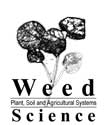|
||
|
|
Challenges associated with managing waterhemp in soybean continue to escalate in Illinois. This summary outlines a few key guidelines for achieving improved control of waterhemp in soybean. The presence of glyphosate-resistant marestail has been documented in Illinois for several years and it can likely be found in any field in the southern half of the state. |
|
|
|
Use of low drift nozzles and drift control agents is essential to managing drift. Knowledge of how they impact spray coverage and overall glyphosate efficacy will be the key |
|
 |
Glyphosate formulations are developed solely with the intent of controlling weeds, not minimizing physical spray drift. Use of low drift nozzles and drift control agents is essential to managing drift |
|
 |
Common university guidelines: In corn It is recommended to remove weeds at 2 to 4 inch heights. In soybeans it is recommended to remove weeds at 6 to eight inch weed heights. |
|
 |
New Herbicides for labeled use |
|
 |
Illinois Winter Annual Grass Species |
|
 |
Originally introduced as a garden plant, star-of-Bethlehem has now gone wild along roadsides, in fields, and in woods. |
|
 |
1. Get 10% greater soybean yield!
2. Herbicides - Investments of just an expense? 3. Can you afford a $180/acre loss? 4. Scout those fields! 5. Be proactive instead of reactive! |
|
 |
Waterhemp is becoming more and more challenging to control with the emergence of plants that are resistant to protoporphyrinogen oxidase inhibitors, photosystem II, and acetolactate synthase inhibitors. |
|
 |
A Look at choices for fall applied herbicides |
|
 |
In summer, it’s crabgrass and goosegrass. In winter it’s chickweed and henbit. Poor weed control results in an ever decreasing stand of turfgrass. There are around 30 winter annual weeds. Here are the top 12. |
|
 |
Research was conducted to better understand the yield benefits and cost effectiveness of intensively managed wheat. |
|
|
|
To get old news from the Weed Science homepage, click here. |
|


